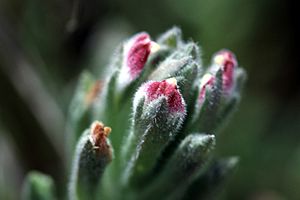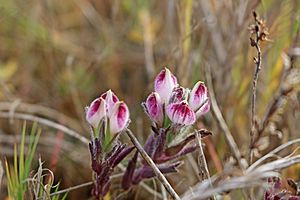Chloropyron maritimum facts for kids
Quick facts for kids Chloropyron maritimum |
|
|---|---|
 |
|
| Chloropyron maritimum subsp. palustris | |
| Scientific classification | |
| Genus: |
Chloropyron
|
| Species: |
maritimum
|
Chloropyron maritimum is a special and rare flowering plant. It's often called the salt marsh bird's beak or Point Reyes bird's beak. These names depend on its specific type, called a subspecies. This plant used to be known by a different scientific name, Cordylanthus maritimus. It belongs to the Orobanchaceae plant family.
Where It Lives
This unique plant naturally grows in the Southwestern United States. You can also find it in northern Baja California, which is in Mexico. It's a halophyte, meaning it loves to grow in very salty places. These places include coastal salt marshes and inland salt flats. Salt flats are dry, flat areas covered with salt.
This plant is also hemiparasitic. This means it's partly a parasite. It has green leaves and chlorophyll, so it can make its own food using sunlight. But it also gets nutrients from other plants. It does this by putting special roots, called haustoria, into their roots.
What It Looks Like
This plant grows in low, small clumps. Its leaves are small, thick, and a gray-green color. They are also hairy and often have a purple tint. The plant collects and gets rid of salts. This makes its leaves look like they have a grainy, crusty coating.
It grows a flower stalk, called an inflorescence, that stands several centimeters tall. This stalk has many fuzzy, club-shaped flowers. These flowers are white or cream-colored with yellow or purplish tips. The plant's fruit is a capsule. This capsule holds many brown seeds that have a net-like pattern.
Why It's Special: An Endangered Plant
Two types, or subspecies, of this plant are considered endangered. This means they are at risk of disappearing forever. One subspecies, Cordylanthus maritimus ssp. maritimus, is listed as endangered by the State of California and the United States Government.
The other subspecies is Cordylanthus maritimus ssp. palustris. This one is also called the Point Reyes bird's beak. It is listed in a special book called the Inventory of Rare and Endangered Plants of California. This book is put together by the California Native Plant Society. It helps keep track of rare and endangered plants in California.


